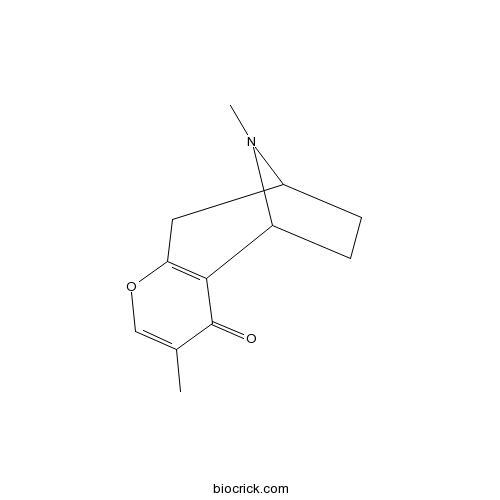BellendineCAS# 32152-73-1 |

Quality Control & MSDS
3D structure
Package In Stock
Number of papers citing our products

| Cas No. | 32152-73-1 | SDF | Download SDF |
| PubChem ID | 442996 | Appearance | Needles |
| Formula | C12H15NO2 | M.Wt | 205.26 |
| Type of Compound | Alkaloids | Storage | Desiccate at -20°C |
| Solubility | Soluble in Chloroform,Dichloromethane,Ethyl Acetate,DMSO,Acetone,etc. | ||
| SMILES | CC1=COC2=C(C1=O)C3CCC(C2)N3C | ||
| Standard InChIKey | ODQUOOUDMCGJCX-UHFFFAOYSA-N | ||
| General tips | For obtaining a higher solubility , please warm the tube at 37 ℃ and shake it in the ultrasonic bath for a while.Stock solution can be stored below -20℃ for several months. We recommend that you prepare and use the solution on the same day. However, if the test schedule requires, the stock solutions can be prepared in advance, and the stock solution must be sealed and stored below -20℃. In general, the stock solution can be kept for several months. Before use, we recommend that you leave the vial at room temperature for at least an hour before opening it. |
||
| About Packaging | 1. The packaging of the product may be reversed during transportation, cause the high purity compounds to adhere to the neck or cap of the vial.Take the vail out of its packaging and shake gently until the compounds fall to the bottom of the vial. 2. For liquid products, please centrifuge at 500xg to gather the liquid to the bottom of the vial. 3. Try to avoid loss or contamination during the experiment. |
||
| Shipping Condition | Packaging according to customer requirements(5mg, 10mg, 20mg and more). Ship via FedEx, DHL, UPS, EMS or other couriers with RT, or blue ice upon request. | ||
| Structure Identification | Australian Journal of Chemistry,1979,32(8):1827-1840.Alkaloids of Bellendena montana[Reference: WebLink]
Phytochemistry,1971,10(2):475-477.Methyl (p-hydroxybenzoyl) acetate and an alkaloid, bellendine, from Bellendena montana[Reference: WebLink]
|

Bellendine Dilution Calculator

Bellendine Molarity Calculator
| 1 mg | 5 mg | 10 mg | 20 mg | 25 mg | |
| 1 mM | 4.8719 mL | 24.3593 mL | 48.7187 mL | 97.4374 mL | 121.7967 mL |
| 5 mM | 0.9744 mL | 4.8719 mL | 9.7437 mL | 19.4875 mL | 24.3593 mL |
| 10 mM | 0.4872 mL | 2.4359 mL | 4.8719 mL | 9.7437 mL | 12.1797 mL |
| 50 mM | 0.0974 mL | 0.4872 mL | 0.9744 mL | 1.9487 mL | 2.4359 mL |
| 100 mM | 0.0487 mL | 0.2436 mL | 0.4872 mL | 0.9744 mL | 1.218 mL |
| * Note: If you are in the process of experiment, it's necessary to make the dilution ratios of the samples. The dilution data above is only for reference. Normally, it's can get a better solubility within lower of Concentrations. | |||||

Calcutta University

University of Minnesota

University of Maryland School of Medicine

University of Illinois at Chicago

The Ohio State University

University of Zurich

Harvard University

Colorado State University

Auburn University

Yale University

Worcester Polytechnic Institute

Washington State University

Stanford University

University of Leipzig

Universidade da Beira Interior

The Institute of Cancer Research

Heidelberg University

University of Amsterdam

University of Auckland

TsingHua University

The University of Michigan

Miami University

DRURY University

Jilin University

Fudan University

Wuhan University

Sun Yat-sen University

Universite de Paris

Deemed University

Auckland University

The University of Tokyo

Korea University
- [D-Trp8]-γ-MSH
Catalog No.:BCC7902
CAS No.:321351-81-9
- EO 1428
Catalog No.:BCC7511
CAS No.:321351-00-2
- Fluoronaphthalene
Catalog No.:BCC8987
CAS No.:321-38-0
- Adenine sulfate
Catalog No.:BCC4451
CAS No.:321-30-2
- Marmin acetonide
Catalog No.:BCN5240
CAS No.:320624-68-8
- Aclidinium Bromide
Catalog No.:BCC4575
CAS No.:320345-99-1
- 5-Azacytidine
Catalog No.:BCC1130
CAS No.:320-67-2
- SIB 1757
Catalog No.:BCC6971
CAS No.:31993-01-8
- Ethyl glucoside
Catalog No.:BCN5239
CAS No.:3198-49-0
- H-β-Ala-OMe.HCl
Catalog No.:BCC2853
CAS No.:3196-73-4
- Norarmepavine
Catalog No.:BCN7077
CAS No.:3195-01-5
- Cornucervine
Catalog No.:BCN1962
CAS No.:31948-48-8
- Z- Pyr-OH
Catalog No.:BCC3330
CAS No.:32159-21-0
- N-Acetyl-4-piperidone
Catalog No.:BCC9079
CAS No.:32161-06-1
- Cytosporone B
Catalog No.:BCN6791
CAS No.:321661-62-5
- BIBR 1532
Catalog No.:BCC1147
CAS No.:321674-73-1
- Poloxin
Catalog No.:BCC1867
CAS No.:321688-88-4
- L002
Catalog No.:BCC8000
CAS No.:321695-57-2
- Pilloin
Catalog No.:BCN6817
CAS No.:32174-62-2
- 1,10:4,5-Diepoxy-7(11)-germacren-8-one
Catalog No.:BCN1460
CAS No.:32179-18-3
- p-3-Methylamino propyl phenol
Catalog No.:BCN1802
CAS No.:32180-92-0
- Triflusal
Catalog No.:BCC4443
CAS No.:322-79-2
- Heraclenol 3'-O-beta-D-glucopyranoside
Catalog No.:BCN1459
CAS No.:32207-10-6
- H-Asp(OMe)-OMe.HCl
Catalog No.:BCC2890
CAS No.:32213-95-9
Metabolomic study of the response to cold shock in a strain of Pseudomonas syringae isolated from cloud water.[Pubmed:30830325]
Metabolomics. 2017 Dec 4;14(1):11.
INTRODUCTION: Active microorganisms have been recently discovered in clouds, thus demonstrating the capacity of microorganisms to exist in harsh environments, including exposure to UV and oxidants, osmotic and cold shocks, etc. It is important to understand how microorganisms respond to and survive such stresses at the metabolic level. OBJECTIVES: The objective of this work is to assess metabolome modulation in a strain of Pseudomonas syringae isolated from cloud water and facing temperature downshift from 17 to 5 degrees C by identifying key molecules and pathways of the response/adaptation to cold shock. METHODS: Bacterial extracts from suspensions of cells grown at 17 degrees C and further incubated in microcosms at 5 and 17 degrees C to mimic cloud conditions were analysed by combining LC-MS and NMR; the results were evaluated in comparison to similar suspensions kept at constant temperature. The differences in the metabolome profiles were deciphered using multivariate statistics (PLS-DA). RESULTS: Key cold shock biomarkers were observed, including cryoprotectants (trehalose, glucose, glycerol, carnitine, glutamate), antioxidants (glutathione and carnitine) and their precursors, alkaloids (Bellendine and slaframine) and metabolites involved in energy metabolism (ATP, carbohydrates). Furthermore, new short peptides (nine dipeptides and a tetrapeptide) were found that have no known function. CONCLUSIONS: This study shows that in response to cold temperatures, Pseudomonas syringae PDD-32b-74 demonstrates numerous metabolism modifications to counteract the impacts of low temperatures.


